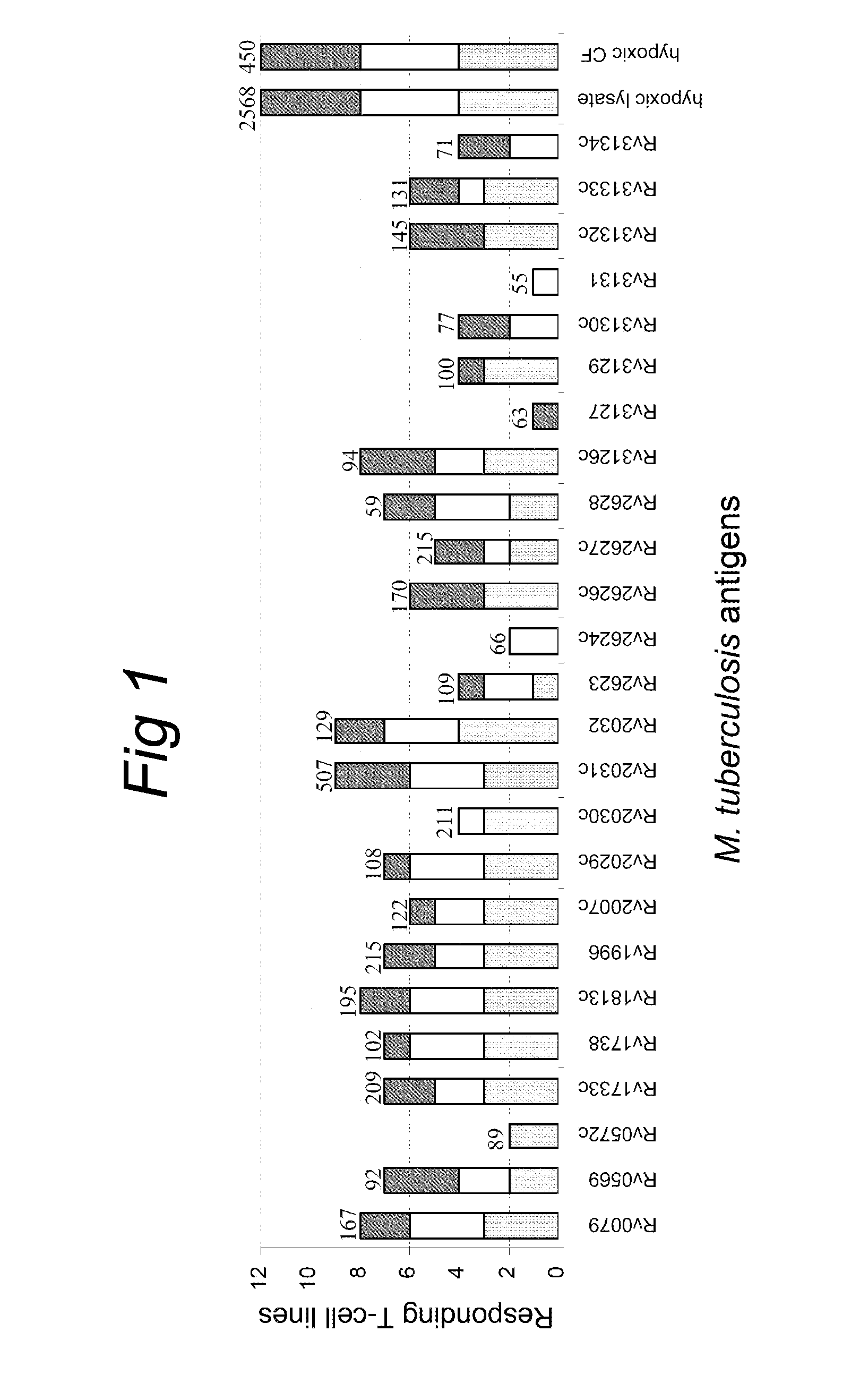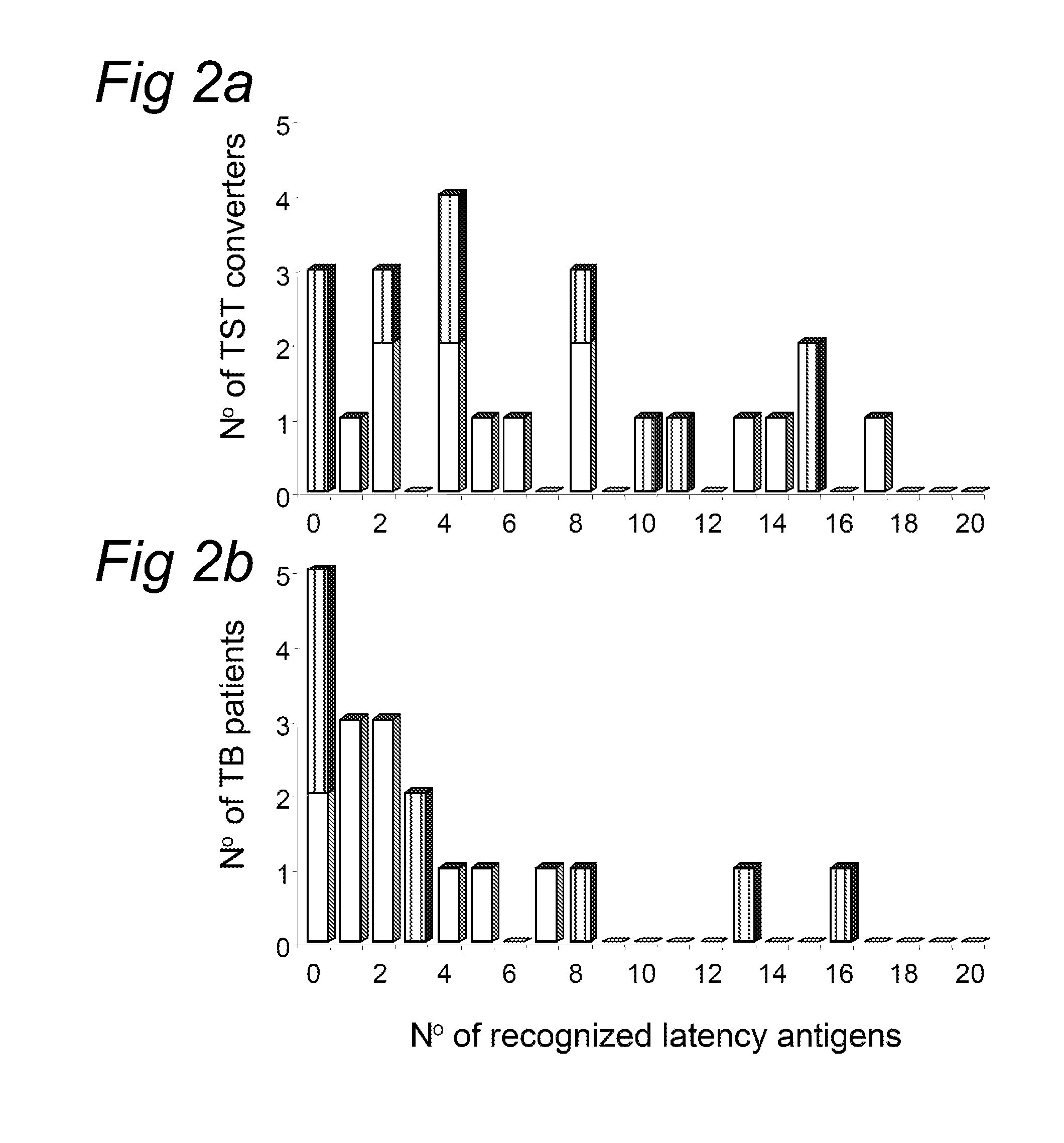Methods and Means for Diagnostics, Prevention and Treatment of Mycobacterium Infections and Tuberculosis Disease
a technology for mycobacterium infections and tuberculosis, applied in the field of medicine, can solve the problems of limited effectiveness of the currently available regimens used for the treatment infections complicating the efforts to eliminate tb, and affecting the treatment effect of latent i>m. tuberculosis /i>infection
- Summary
- Abstract
- Description
- Claims
- Application Information
AI Technical Summary
Benefits of technology
Problems solved by technology
Method used
Image
Examples
example 1
Selection of Immunogenic Latency Antigens
[0084]Antigens were selected from the recently-identified dormancy regulon of M. tuberculosis, consisting of 48 genes (table 2) which were found to be induced during NRP, oxygen limitation and during low dose nitric oxide exposure (17). As most of these genes are hypothetical open reading frames with unknown function a selection of the genes for this post-genomic antigen discovery project could not be based on protein function. Therefore, we chose to select the genes on their level of induction. For this purpose, a mean fold induction was calculated for each individual gene, based on the fold inductions as observed by Voskuil et al. in the three different in vitro models of latency (17). Of the data from 48 candidate genes, the 25 most strongly induced genes were selected for cloning and expression of recombinant proteins (Table 1; FIGS. 7i and 8i). These hypothetical proteins were subsequently tested in equal molar concentrations in order to...
example 2
Interferon-γ Production by PBMC in Response to M. tuberculosis Latency Antigens
[0086]Subsequently, the 25 latency antigens were studied for the induction of IFN-γ production by PBMC of 20 TB patients, 23 TST positive healthy individuals and 21 uninfected control subjects. For each individual latency antigen, the proportion of responding (IFN-γ≧100 pg / ml) study subjects per group was calculated (Table I). We also calculated the proportion of responders among all 43 M. tuberculosis infected individuals, taking together 20 TB patients and 23 TST positive individuals. The latter analysis showed that 19 latency antigens were recognized by at least 5% of the M. tuberculosis infected individuals, with Rv1733c being recognized by the majority (56%) of the infected individuals. The remaining 6 antigens tested, Rv0572c, Rv2623, Rv2624c, Rv3127, Rv3131, Rv3134c were not or very poorly recognized by M. tuberculosis infected individuals. Similar recognition profiles were found when proliferation...
example 3
TB Patients and TST Positive Individuals Respond Differently to Latency Antigens
[0088]Median IFN-γ responses in the group of TB patients and TST converters were determined for each latency antigen. Considering the 25 latency antigens as a group, the median IFN-γ responses were consistently and significantly higher in TST positive individuals, who are considered to be latently infected with M. tuberculosis, than in TB patients (PM. tuberculosis-lysate in the same individual. This analysis corrects for a possible inter-individual variation in the general responsiveness of T cells. When the above Friedman analysis was repeated, now comparing the medians of these ratio's, it was confirmed that latency antigens were preferentially recognized by TST positive individuals (P<0.01).
[0089]When comparing the proportions of responders in the group of TST positive individuals and the group of TB patients for each individual latency antigen, it was found that nearly all latency antigens were reco...
PUM
| Property | Measurement | Unit |
|---|---|---|
| Fraction | aaaaa | aaaaa |
| Fraction | aaaaa | aaaaa |
| Fraction | aaaaa | aaaaa |
Abstract
Description
Claims
Application Information
 Login to View More
Login to View More - R&D
- Intellectual Property
- Life Sciences
- Materials
- Tech Scout
- Unparalleled Data Quality
- Higher Quality Content
- 60% Fewer Hallucinations
Browse by: Latest US Patents, China's latest patents, Technical Efficacy Thesaurus, Application Domain, Technology Topic, Popular Technical Reports.
© 2025 PatSnap. All rights reserved.Legal|Privacy policy|Modern Slavery Act Transparency Statement|Sitemap|About US| Contact US: help@patsnap.com



